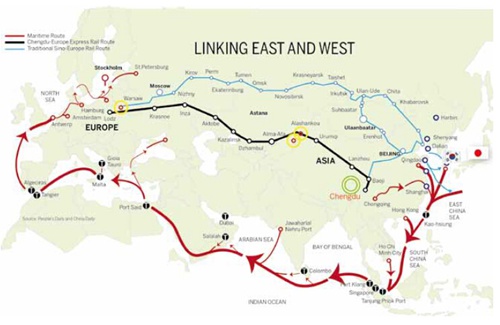Sichuan capital transports itself to new era of trade and travel
( China Daily )
Updated: 2016-05-31

The rapid development of Chengdu’s railway networks has led to a surge in trade between locally based companies and European countries.
In line with China’s westward opening-up and the Belt and Road Initiative, Chengdu launched an express rail route on April 26, 2013, linking it to Lodz, Poland.
The Chengdu-Europe Express Rail, stretching 6,100 miles, is the fastest and most frequently used direct freight route from China to Europe. A one-way trip takes only 10 days, after which cargo is distributed to customers via rail and road networks throughout Europe in less than three days, according to the Chengdu Port and Logistics Office.
Express rail is much faster than alternative sea routes, giving Chengdu a distinct advantage over China’s other eastern coastal cities when it comes to trading with Europe.
In the past three years the express rail has run more than 200 journeys, transporting Dell laptops, iPads, Philips lighting products, auto parts and home appliances to Europe, and bringing back mechanical and electrical products, food and beverages.
Last year products made in Chengdu worth $300 million were exported to Europe using the express rail, Chengdu Customs said.
Many companies in provinces around Chengdu, and even those in eastern coastal cities and provinces such as Shanghai, Zhejiang, Fujian and Guangdong, also chose to transport their goods on the express rail. On March 25 last year a train carrying 20,000 semi-finished color TVs made at TCL ’s Huizhou plant in Guangdong province headed to Europe on the express rail. The TVs were to be finished in Poland and eventually sold throughout Europe.
Since last January TCL has transported 468 metric tonnes of cargo worth 53.72 million yuan ($8.3 million) via express rail, Chengdu Customs said. “We used to send the semifinished TVs to our factory in Poland by sea, which takes 27 days,” said Liu Guifang, project director of TCL ’s operations center. “The express rail saves us a lot of time, cutting transport time to around 10 days.” Liu said the express rail gives her company a more direct and convenient channel through which to do business with its European customers.
The company plans to produce TVs for export at its Chengdu plant and export them weekly via the express rail.
The city is playing a greater role in collaboration and exchanges between China and Europe as it advances the idea of a “Chengdu-Europe Plus” strategy, which refers to further rail connections with both domestic and European cities.
On April 30 an express train carrying 41 containers fully loaded with auto parts, food and wine departed from Kutno, Poland, for Chengdu, after an opening ceremony of the Chengdu express rail service.
Kutno railway station, in central Poland, is one of Europe’s most important logistics hubs. “Kutno railway station is an important logistics hub giving Chengdu additional links to Nuremberg in Germany and Tilburg in the Netherlands,” an official at the Chengdu Port and Logistics Office said.
Under the Chengdu-Europe Plus strategy, the express rail will connect with more logistics hubs in Europe, while in China it is expanding to Chinese cities including Shanghai, Shenzhen, Xiamen and Kunming. The express rail is expected to run 400 journeys this year, helping to strengthen both Chengdu’s strategic position in the Belt and Road Initiative and Sino-European economic and trade ties, the official said.
To boost its collaboration with Central Asia, Chengdu opened the Chengdu-Central Asia Express Rail in July 2014, allowing much more rapid access to countries in Central Asia within nine to 11 days.
The city is also upgrading its domestic railway network. By 2020 it will be possible to travel between Chengdu and Chongqing and other nearby cities within an hour, major cities such as Xi’an, Kunming, Guiyang and Wuhan within four hours, and to the Yangtze River Delta, Pearl River Delta and the Bohai Rim area within eight hours.
Chengdu also improved its transport links to the Yangtze River and developed road-river transportation routes along the river through collaboration with port cities including Yibin, Luzhou and Wuhan.
Aviation hub
The city is also developing into a world-class aviation hub to expand its global connectivity.
The National Development and Reform Commission approved the construction of the Chengdu Tianfu International Airport in April, according to comments on the commission’s official website responding to a feasibility study into plans for the airport.
This would make Chengdu the third city on the Chinese mainland to have a second civil aviation airport. With total investment of 72 billion yuan, Chengdu Tianfu International Airport will be located in Lujia township, 31 miles southeast of downtown Chengdu. It is expected to be completed in 2019 and to open in 2020, said Dai Yongbo, deputy director of the Sichuan Development and Reform Commission.
Liu Yi, deputy chief architect of the China Southwest Architectural Design and Research Institute, which designed the new airport, said the first phase of the project will include three runways able to handle 320,000 flights, 40 million passengers and 700,000 metric tonnes of cargo annually by 2025.
In the long-term there are plans for the airport to have six runways with an annual capacity of 90 million passengers and 2 million tonnes of cargo. Through the intercity railway, highway and subway links to the new airport, passengers will be able to easily reach downtown Chengdu and its neighboring cities. The subway that will connect the new airport with the downtown area will travel at up to 87 miles an hour, meaning that a one-way trip will take only half an hour.
With rapid economic development and more frequent international exchanges, Chengdu has seen a sharp increase in its air traffic in recent years.
Chengdu Shuangliu International Airport is the fourthbusiest airport on the Chinese mainland. It handled 42 million passengers last year, 12 percent more than the year before, the Civil Aviation Administration of China said.
Passenger volume has continued to rise even though the airport is operating at peak capacity, hence the decision to build a new airport.
“Experts expect annual aviation passenger volume in Chengdu to reach 75 million by 2025,” said Zhang Xicheng, assistant to the general manager of the Sichuan Province Airport Group.
Zhang said the new airport will serve international passenger routes and most international cargo routes, while Shuangliu airport will handle domestic flights and some international cargo routes.
“The new airport is of vital importance in Chengdu’s plans to build a modern transportation system and boost opening up and regional development,” Dai said. He added that only the new airport in Beijing is larger in size among airports being built in China.
Chengdu benefits from its geography, as many of the air routes from China to Europe overfly the city, he said. The new airport is expected to attract more international air routes, making Chengdu a key hub linking western China with the world.
Chengdu already has 86 international routes, the largest number in China’s central and western region, linking it to cities including San Francisco, London, Paris, Moscow, Doha and Melbourne.
In February Sichuan Airlines launched a direct route between Chengdu and Prague, the sixth direct route linking the city to Europe.
Chengdu also plans to open direct routes to other cities including New York, Sydney, Rome and Johannesburg this year, the Sichuan Port and Logistics Office said.



